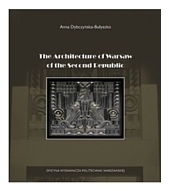|
||
• wydawnictwa polskie
• Zamów informacje o nowościach z wybranego tematu • kontakt
• Cookies na stronie |
THE ARCHITECTURE OF WARSAW OF THE SECOND REPUBLIC THE WARSAW SCHOOL OF ARCHITECTURE AGAINST A BACKDROP OF THE CULTURAL CHANGES OF THE INTERWAR PERIODDYBCZYŃSKA-BUŁYSZKO A.wydawnictwo: WYD PW , rok wydania 2018, wydanie Icena netto: The Architecture of Warsaw of the Second RepublicThe Warsaw School of Architecture Against a Backdrop of the Cultural Changes of the Interwar PeriodThe author deals with the architecture of mid-war Warsaw but she presents it in a very wide anthropological context – aesthetic, cultural, social, technical, philosophical, economic... Therefore, in this book everyone can find something inspiring–appreciate the beauty of the presented objects, understand their functions, learn about the history of Warsaw, find a connection with the present, and first of all, learn to “read architecture”–notice how much it can tell us about the societies that created it...“The Architecture of Warsaw of the Second Republic”
is a book containing just about a complete over view of social ideas and artistic
programs, urban and cultural policy, and organizational and administrative constraints
applied in the practice of architecture of the discussed period. There is also a
discussion of the myths and traditions that were referred to and the schools of
architecture and artistic groups that created or inspired it. It also describes the
achievements of the most renowned designers of that time. All this is done with extensive
erudition and familiarity with literary, artistic, and even philosophical contexts... This
is especially true as in the form applied by the author, the interwar period is presented
as a period that was truly fruitful and rich in both ideas and their implementation.
Looking from a perspective of postwar achievements in this field, it stirs admiration and
envy. Foreword
. Myth and Reality
. “Dwelling and City”
“The Warsaw School”
“New Art”
Making Space Dynamic
The City and the Authorities
. The Architecture of a New Humanism
. A Summing Up
Conclusion
304 + 36 pages, Paperback, 240 × 270 Księgarnia nie działa. Nie odpowiadamy na pytania i nie realizujemy zamówien. Do odwolania !. |


